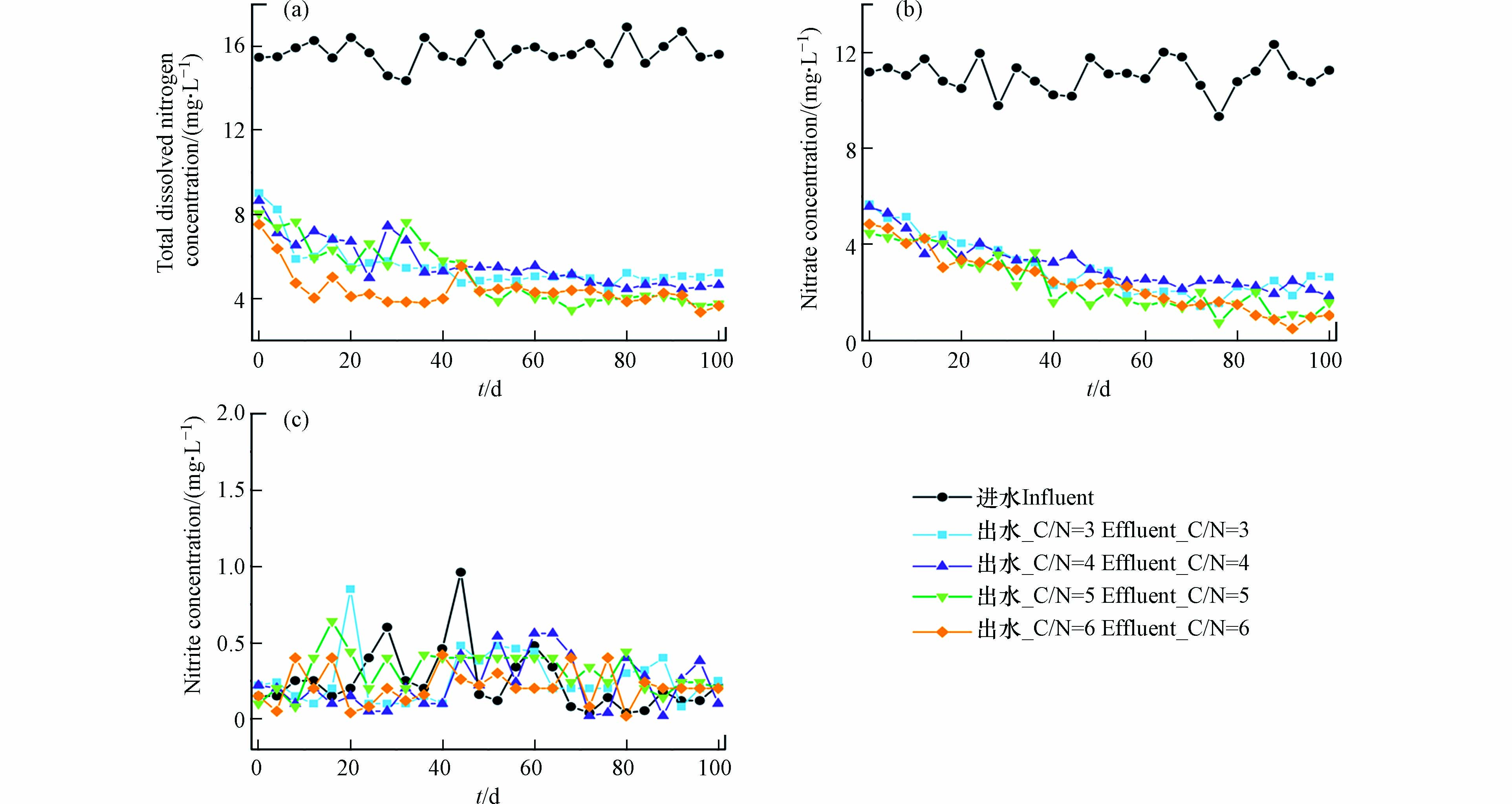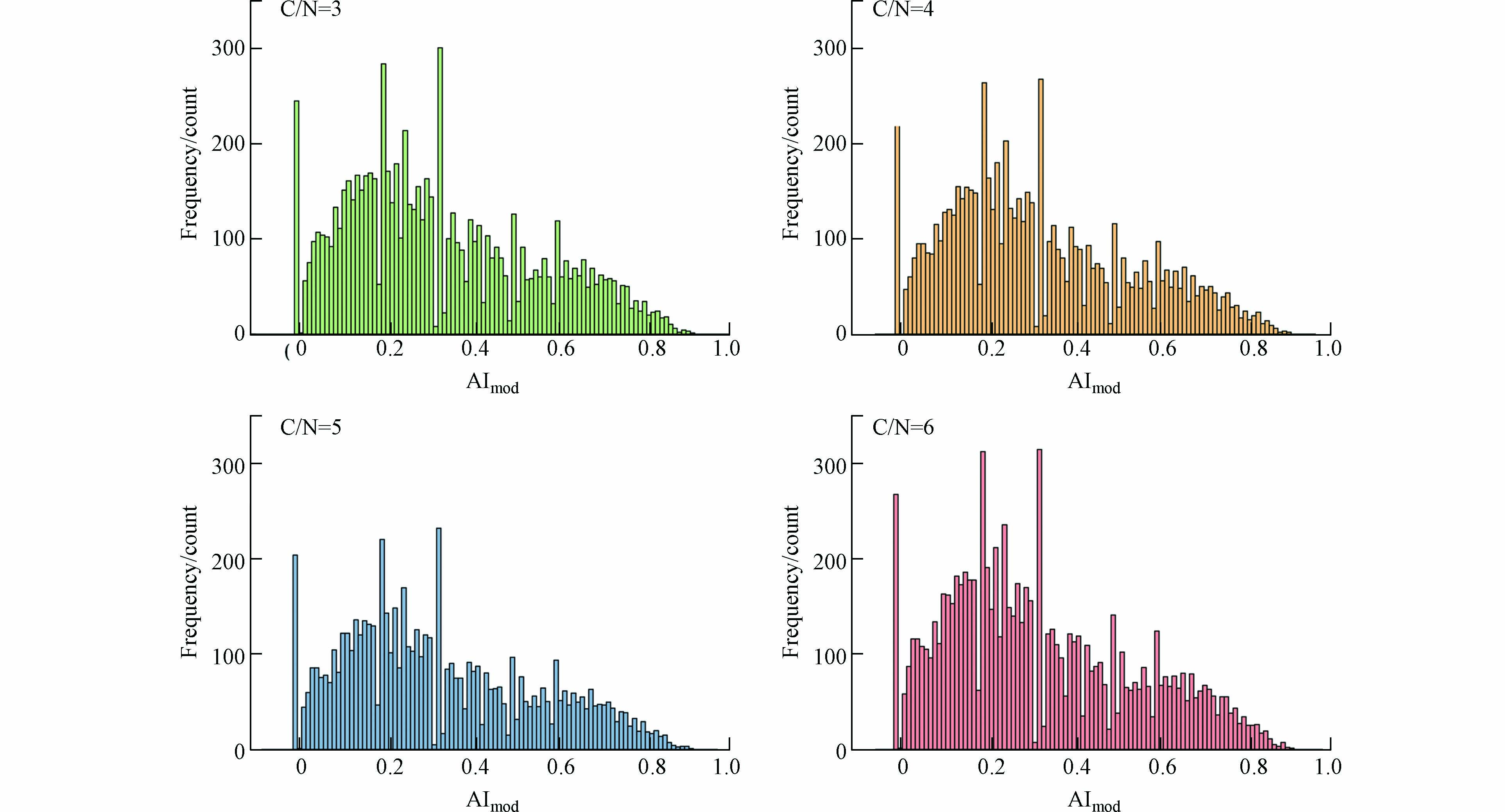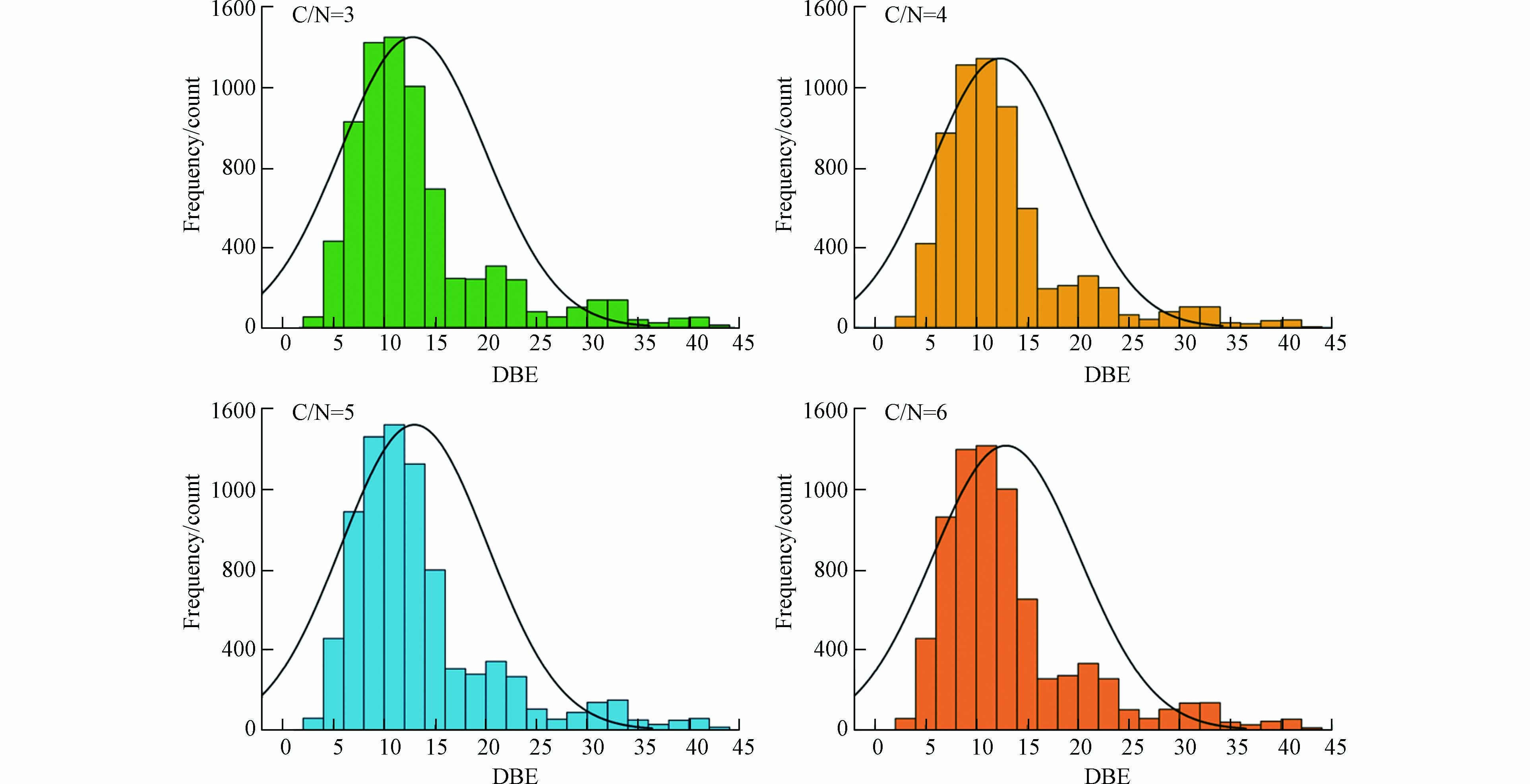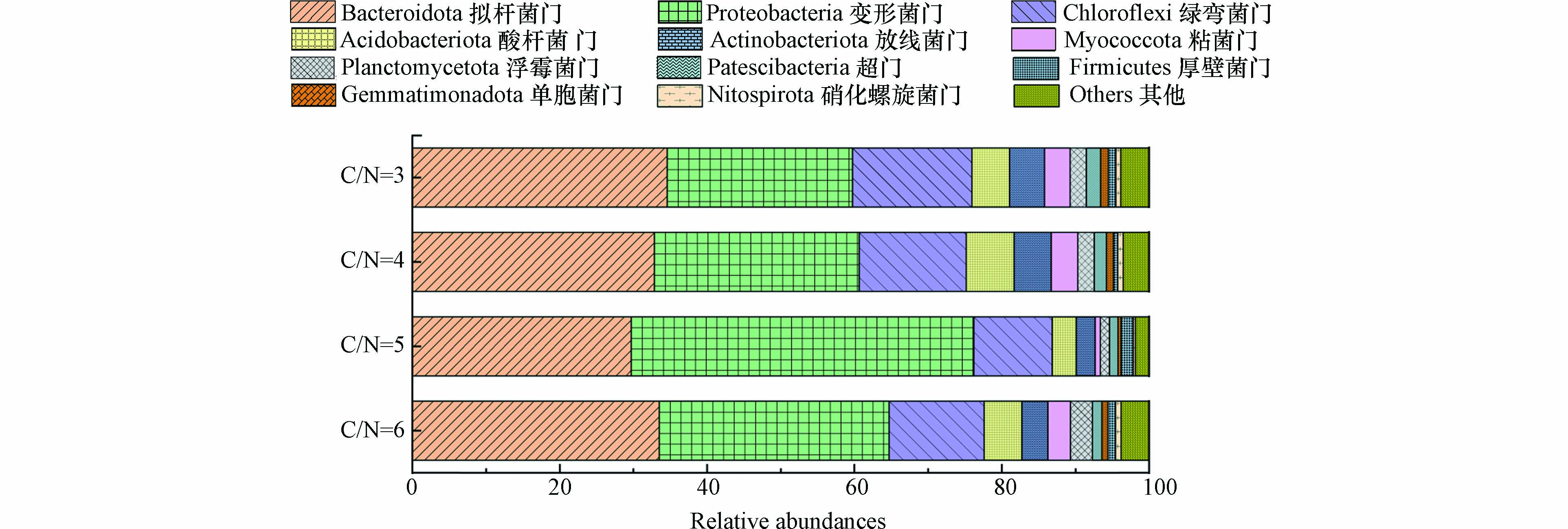-
随着污水厂出水总氮标准的提高(总氮≤10 mg·L−1)[1],传统生物脱氮工艺不能满足低出水总氮排放要求,污水厂面临提标改造需要进行深度脱氮[2]. 当前废水深度脱氮工艺主要有后置反硝化脱氮工艺、反硝化生物滤池、移动床生物膜反应器、人工湿地法等[3]. 新型后置反硝化脱氮工艺具有脱氮效果好的优点,还可利用部分内源性碳源[4],操作管理简便,且降低了运行费用[3,5],并在一定程度上减少剩余污泥的产量,是解决深度脱氮最具发展潜力的技术之一[6].
后置反硝化工艺依赖二级出水中残留的有限碳源实现脱氮的反硝化效率低[7],因此为了保证反硝化脱氮的效率,通常需要在进水中外加碳源[8 − 9]. 传统的外加碳源主要有甲醇、乙醇、乙酸盐、乙酸钠等[10]. 现有研究表明,乙酸钠用做外加碳源时,其反硝化速率远高于外加甲醇等碳源[5],且甲醇和乙醇的投加不仅增加运营成本,乙醇的运输和甲醇对人类健康的影响都存在风险[11]. 此外,碳源为异养反硝化提供电子供体[12],外加碳源的投加量即碳氮比(carbon-to-nitrogen,C/N)会影响电子供体传递[13]和碳源降解,显著影响反硝化脱氮性能[14].
碳源在被后置反硝化工艺中的异养微生物利用和转化产生一部分溶解性有机质(dissolved organic matter,DOM) [7,15],加上进水中原有的难降解天然有机质,出水中含有大量的DOM是出水水质面临的重要议题,出水DOM不仅对后续的高级处理(即膜和高级氧化)产生负面影响,带来膜污染,更严重的会影响反硝化出水水质,具有潜在的环境生态风险[16 − 17]. 污水中DOM的组成和结构非常复杂[18],来源亦尚不清晰,研究发现其可能源于进水原水或者污水处理中的微生物[19],污水生物处理中DOM的组成和特性还会受到微生物生长代谢和工艺运行参数(如,污泥龄(solid retention time,SRT)、C/N比)的影响[20 − 21]. 然而,目前大多数研究主要集中在增强后置反硝化工艺反硝化性能上,对于工艺投加外加碳源进行深度脱氮后,如何影响出水DOM特性,以及关于DOM在工艺中的转化和利用规律鲜有报道. 傅立叶变换离子回旋共振质谱(Fourier transform ion cyclotron resonance mass spectrometry,FT ICR-MS)已被用于DOM的分子特性表征[22],该技术具有超高分辨率和高质量准确度[23],能够解析复杂DOM中的分子组成特征[24]. 在现有研究中,运用FT ICR-MS研究DOM主要集中在雨水、河流、海洋和等自然水体[25 − 26],然而污水处理厂出水DOM对于受纳水体的影响和水生态环境安全风险已逐渐成为人们关注的环境议题[27],因此,有必要运用该技术探究污水后置反硝化工艺中DOM的分子特征及转化规律.
本研究以实际污水中DOM为研究对象,选取常用碳源乙酸钠为外加碳源,采用FT ICR-MS分析了不同C/N比下后置反硝化工艺中DOM的浓度分布和分子转化特征,并结合16S rRNA基因高通量测序考察微生物与DOM分子的关联分析,探究DOM在不同C/N比下后置反硝化工艺中的转化机制,为污水厂后置反硝化工艺中DOM的调控和出水水质改善提供理论支撑.
-
(1) 实验用水与接种污泥
室内模拟所接种的活性污泥取自南京某市政污水处理厂的缺氧池,该厂采用的是厌氧-缺氧-好氧(A/A/O)生物处理工艺. 接种前将污泥先过滤去除砂粒、纸屑等固体杂质(自来水冲洗3次),并对其采用去离子水(Milli-Q)漂洗3次,去除生活污水中残余成分;将处理后污泥用氮气曝气2 h再放于密封性良好的厌氧反应器中静置 24 h,意在使污泥通过内源呼吸消耗掉细胞内的残余物质,然后放于序批式活性污泥反应器(Sequencing batch reactor,SBR)中进行驯化. 测定其混合液悬浮固体浓度(Mixed liquor suspended solids,MLSS)约为
3500 mg·L−1,污泥沉降指数(Sludge volume index,SVI)为110—115 mL·g−1,说明接种污泥具有良好的松散程度和凝聚沉降性能.实验所用废水取自南京某市政污水处理厂的二级出水,该厂采用的是A/A/O生物处理工艺. 根据后置反硝化外加碳源的需要,选择常用碳源乙酸钠作为反应器的外加碳源[28],C/N比选择3、4、5、6等4种进行碳源的配比添加,具体组分及浓度情况详见表1.
(2) 实验装置与运行条件
本实验采用SBR反应器运行后置反硝化工艺,由有机玻璃制成,反应器内径为10 cm,高60 cm,整体容积约为3.5 L,本实验所需的有效容积为3 L. 设置C/N=3、4、5、6的4个SBR 反应器,运行周期为 3 h,每天运行 8个周期,采用电子定时器,自动控制反应进出水. 每个反应器基本工作周期如下:进水 5 min;反应 140 min;沉淀30 min;出水 5 min [29]. 反应器采用瞬时进水,每周期进水体积为1 L,充水比为1/3,水力停留时间(Hydraulic retention time,HRT)为9 h. 反应器使用电动搅拌器进行缺氧搅拌,转速维持在150 r·min−1,使其溶解氧(DO)控制在0—0.5 mg·L−1. 反应器运行温度维持在(20±5) ℃,后置反硝化SRT为20 d.
-
污水水样取自SBR反应器的进水和出水,采集后的污水水样经过0.45 μm醋酸纤维滤膜过滤后置于棕色玻璃瓶中,放入4 ℃冰箱中保存备用. 反应器驯化稳定后,在完全混合状态下取各反应器活性污泥15 mL,在4 ℃、
5000 r·min−1离心15 min,弃上清,-80 ℃快速冷冻保存. 每个水样和泥样一式三份作平行样保存. -
定期监测后置反硝化反应器进出水水质和污泥浓度变化情况. 污水样品的溶解性有机碳(Dissolved organic carbon,DOC)采用总有机碳分析仪(multi N/C
3100 TOC, Analytik Jena AG)测定,化学需氧量(COD)采用重铬酸钾消解法测定[30],样品的总溶解性氮(Total dissolved nitrogen,TDN)、硝酸盐氮(Nitrate)、亚硝酸盐氮(Nitrite)和总磷(TP)浓度使用连续流动分析仪(SAN++,SKALAR)测定. MLSS浓度采用重量法测定. 后置反硝化反应器的溶解氧(Dissolved oxygen,DO)浓度由HQ30d便携式仪(Hach, USA)监测. -
(1)固相萃取
将500 mL预处理后的水样用盐酸(HCl)调节至pH=2,采用反相固相萃取的方式进行富集. 首先,将苯乙烯/二乙烯基苯共聚物(PPL)材质的固相萃取柱(ENVI-Chrom P, Supelco)进行活化,即依次加入10 mL的LC-MS甲醇冲洗,并用至少20 mL的酸化Milli-Q水(pH = 2)清洗以激活固相萃取柱. 其次是将预处理后水样中的DOM富集于固相小柱,以3 mL·min−1的流速泵入SPE滤芯. 样品通过树脂后,用至少20 mL的酸化Milli-Q水(pH = 2)冲洗固相萃取柱,以完全去除无机盐分. 随后固相萃取柱在真空条件下干燥,直至填充层松动以去除水分,最后用10 mL的LC-MS甲醇缓慢(3 mL·min−1)通过PPL固相萃取柱,洗脱萃取柱上富集的DOM,收集洗脱液并稀释,在-20 ℃下避光保存待后续进行FT ICR-MS分析测定.
(2)仪器参数与操作步骤
固相萃取后的DOM通过15.0 T FT ICR-MS(SolariX,Bruker)测定. 本研究采用电喷雾离子源(ESI)和负离子模式结合FT ICR-MS分析不同C/N比后置反硝化反应器的DOM分子组成. 以下是仪器设置的参数. 进样速度为120 μL·h−1,喷雾罩电压为3.5 kV,毛细管入口电压为−3.8 kV,离子累积时间为0.2 s,温度为200 ℃,采集的质量分子范围在80—800 Da,采样点数为4 M 32位数据,扫描图谱叠加200次以提高信噪比. 仪器使用前用标准有机物校准,每个样品之间加一个甲醇空白样,以保障样品之间没有污染.
(3)数据处理
利用高分辨率质谱数据处理程序对信噪比>6的所有质谱峰进行处理,根据其质荷比计算并匹配分子式[31],元素组成需满足以下组合:12C1–601H1–12016O1–5014N0–432S0–231P0–2. 此外分子式组成还需满足以下条件:符合偶氮规则、0 ≤ O/C ≤ 1.2、0.33 ≤ H/C ≤ 2.25、N/C ≤ 0.5、S/C ≤ 0.2、P/C ≤ 0.1、(S+P)/C ≤ 0.2、N < O、S < O、(2S+P) < O、质量误差小于1.0 ×106、等效双键数(DBE)为非负整数.
相对强度(RI)是由各分子式的绝对强度(I)除以该样品中所有分子式的绝对强度之和计算得到(式1). 分子式的等效双键数(Double bond equivalents,DBE)、修正芳香指数(Modified aromatic index,AImod)的计算公式如下(式2、式3). 分子参数的强度加权平均值(wa)是样品中每个分子参数值乘以相应的相对强度后再进行加和得到(式4-5)[32].
分子动力学根据DOM分子在后置反硝化处理过程中峰强度的变化将其分为3类:产生(produced)、去除(removed)和不变(shared)的分子. 产生的分子是指在生物处理过程中新出现的分子(如存在于后置反硝化反应器出水中,而不存在于进水中的分子). 被去除的分子则是相反的情况(如消失在后来的出水中,但发现在进水中的分子). 不变的分子被定义为在前后两种情况中都存在的分子(如同时存在于后置反硝化反应器的进水与出水中的分子).
-
取4个后置反硝化反应器稳定运行后期污泥样本进行测序分析,一式三份. 测序工作委托上海美吉生物医药科技有限公司完成,测序使用Illumina MiSeq测序平台完成. MiSeq测序反应器采用Illumina成熟的TruSeq边合成边测序技术,通过逆终止试剂方法对数百万个片段同时进行大规模平行测序.
-
微生物门水平之间的显著相关性(Spearman r,P)采用R4.2.2软件中psych包计算. 冗余分析(RDA)采用canoco4.5软件. 所有显著和强相关性(|r| > 0.6, P < 0.05)在使用Gephi 0.9.7进行可视化[33]. 单因素方差分析(ANOVA)采用SPSS 19.0软件进行计算分析.
-
4个不同C/N比的后置反硝化反应器运行了5个SRT(100 d),达到较为稳定的脱氮除碳效果. 首先是后置反硝化反应器中进出水COD的浓度变化(图1). 反应器启动运行一周,4个反应器的出水COD平均浓度小于20 mg·L−1,表明4个C/N比下后置反硝化反应器的反应器启动运行效果较好. 驯化后期阶段,4个反应器稳定运行3个SRT后出水COD浓度在9.86—14.52 mg·L−1之间. C/N=3和C/N=4的反应器的COD去除率逐渐提升至81.2%和82.6%,而C/N=5和C/N=6的反应器的COD去除率可达85%以上,且单因素方差分析结果显示,这两组反应器出水COD浓度存在显著差异(P < 0.01).
图2描述了4个后置反硝化反应器对氮素去除效果的研究. C/N=3、4、5、6的4个反应器TDN平均去除率分别为68.9%、72.3%、75.6%和76.4%,随着C/N比的增加而升高,与之前的研究结果较为一致[34]. 其中,硝酸盐的去除与COD去除规律一致,C/N=3和C/N=4的两个反应器的硝酸盐去除率(77.6%—79.9%)远低于C/N=5和C/N=6的反应器(85.7%—88.9%),存在显著差异(P < 0.05). 结果表明,C/N=5和C/N=6后置反硝化反应器的脱氮除碳性能优于C/N=3和C/N=4的反应器. 综上所述,C/N比不但影响深度脱氮效率[35],也会影响后置反硝化出水有机物的浓度分布,具体影响机制有待进一步探究.
-
图3为后置反硝化工艺处理后出水中DOM的浓度分布,由4个后置反硝化反应器经5个SRT的稳定运行后采集进出水水样测定DOC浓度得到. C/N=3、4、5、6的4个反应器进水中DOC浓度为21.4—37.3 mg·L−1,经后置反硝化工艺处理后,出水DOC浓度下降到5.84—8.13 mg·L−1,具有显著性差异(P < 0.05). 现有研究发现污水处理厂二级出水和深度处理出水的DOC含量高于自然水体[36 − 37],表明污水处理厂是DOC积累的重要场所. 而4个反应器的DOC矿化率最高的是C/N=6的反应器(78.2%),其次是C/N=4(77.2%)和C/N=5(75.2%),C/N=3的DOC矿化率最低(70.7%). C/N=3的后置反硝化反应器外加碳源不足,无法满足反硝化过程中所需的电子供体,微生物降解有机物进行碳代谢的速率较慢[38],导致其DOC去除率低. 综合DOC浓度分布和去除矿化率的差异,不同C/N比对DOM的去除机制存在较大差异,有必要从分子水平对不同C/N比下DOM的转化特征进行分析.
-
C/N=3、4、5、6的后置反硝化反应器出水DOM分子式总数分别是
7946 、7117 、8052 和8624. 基于AImod和H/C将FT ICR-MS分配的DOM分子分为5类化合物[39 − 40]:(1)稠环多环芳烃(AImod > 0.66);(2)多酚类物质(0.5 < AImod < 0.66);(3)高度不饱和酚类物质(AImod < 0.5, H/C < 1.5);(4)脂肪族化合物(1.5 < H/C < 2.0);(5)碳水化合物(H/C > 2.0). 对不同条件下DOM分子的相对丰度(表2)进行分析发现,进出水中DOM分子的主要组成均为高度不饱和的酚类物质(66.00%—67.73%)和多酚类物质(13.8%—14.26%),没有显著性差异. 但值得注意的是,4个反应器经过后置反硝化处理,出水中的脂肪族DOM分子的相对丰度从进水中的1.34%升至8.38%—8.56%(ANOVA,P < 0.05). 现有研究表明污水处理过程中微生物降解有机物进行生长代谢,会裂解、释放微生物溶解性产物主要包括含氮的类蛋白、碳氢化合物和脂质[41 − 42],因此可推测后置反硝化出水中脂肪族DOM分子相对丰度升高源于微生物自身产物的贡献.为进一步对比不同C/N比下后置反硝化工艺中DOM分子组成的差异,采用AImod和DBE指数分别衡量有机物分子的芳香性和不饱和度(图4和图5). 其中,AImod数值反映了化合物C=C双键的“密度”,可以根据DOM分子的元素组成来推断它是否具有苯环(狭义)结构,是质谱分析中常用的鉴别芳香族/稠环芳族结构的分子参数. AImod指数用于指示有机物中的芳香族组分,AImod > 0.5可表征必然含有芳香族结构的化合物[43],被认为比较少或非芳香族的分子(AImod ≤ 0.5)更难以被生物降解[44 − 45]. 在后置反硝化处理过程中,4个C/N比反应器中的芳香度都有一定程度的升高 (平均AImod从进水中的0.371上升到到出水中的0.531—0.538). 现有研究发现芳香性物质在没有氧气存在的条件下更容易积累[44,46],因此经过反硝化处理后AImod指数升高也就不足为奇了. 图4所示的不同C/N比下后置反硝化工艺中DOM分子的AImod频率分布图,其中C/N=5的反应器中AImod > 0.5的DOM分子占比为24.72%,C/N=3和C/N=6的反应器中这一占比降低到23.46%,而C/N=4的反应器占比最低为22.31%.
此外,DBE是化合物分子双键数和环数之和,可以衡量物质的不稳定性,DBE值大于等于4可被视为含苯环结构,即化合物的芳香性和不饱和程度较高[47],生物活性低且难生物降解[48]. DBE分布图(图5)可以得到C/N=5的反应器中DBE ≥ 4的DOM分子占比为97.65%,大于其他3个反应器中这一占比(95.98%—96.4%). 由此可得,C/N=5的后置反硝化反应器出水中DOM的不饱和程度更高. Zhang等[37] 研究表明,高度不饱和DOM对生物降解具有抗性,即C/N=5的反应器出水中DOM的可生物降解性比C/N=3,4,6的反应器低,与上述AImod指数的变化规律总结的结论一致.
综上,对于不同C/N比下后置反硝化反应器出水DOM的分子组成和特征分析可知,各反应器中芳香性DOM分子的占比为:C/N=5 > C/N=3 = C/N=6 > C/N=4;而各反应器中高度不饱和DOM分子占比为:C/N=5 > C/N=3 > C/N=6 > C/N=4. 结果表明C/N=5的反应器出水相较于其他3个反应器具有更高比例的不饱和度高、不易生物降解的DOM分子.
图6通过Van Krevelen图可视化不同C/N比后置反硝化进出水DOM的分子转化特征,分别以氧碳比(O/C)和氢碳比(H/C)为横纵坐标,不同的颜色分别代表根据分类方法定义的3类DOM分子:产生的、去除的和不变的[32]. 再根据FT ICR-MS所鉴别出的分子O/C和H/C值,将DOM分子分为7大类,分别为脂质类(0 ≤ O/C ≤ 0.2,1.7 ≤ H/C ≤ 2.2)、蛋白/氨基糖类(0.2 ≤ O/C ≤ 0.6,1.5 ≤ H/C ≤ 2.2)、糖类(0.6 ≤ O/C ≤ 1.2,1.5 ≤ H/C ≤ 2.2)、木质素类(0.1 ≤ O/C ≤ 0.6,0.6 ≤ H/C ≤ 1.7)、单宁酸类(0.6 ≤ O/C ≤ 1.2,0.5 ≤ H/C ≤ 1.5)、不饱和碳氢化合物(0 ≤ O/C ≤ 0.1,0.7 ≤ H/C ≤ 1.5)和稠环芳烃类(0 ≤ O/C ≤ 1.0,0.3 ≤ H/C ≤ 0.7)[19].
如图6和表3所示,产生的DOM分子相对丰度在C/N=3,4,5反应器中分别是24.38%,47.18%,和58.35%,在C/N=5的反应器中占比最大,但在C/N=6的反应器中只占24.04%,表明C/N=5的反应器中DOM分子组成变化最大. C/N=5的反应器产生的DOM分子的DBEwa(14.5)和AImodwa(0.393)高于其他3个反应器(表4),图6和表5可得其产生木质素类的DOM分子数最多(
3157 ),高于其他3个反应器(1292 —2322 ). 现有研究发现AImod与木质素含量呈正相关[49] ,这类物质难以被生物降解,表明C/N=5的反应器新产生的DOM分子不饱和程度和芳香性高于其他反应器. C/N=5的反应器去除的DOM分子占比最低(2.80%),其DBEwa(10.3)低于其他3个反应器(表4),证明其去除的DOM分子不饱和度也低于其它反应器去除分子的不饱和度. 不同碳氮比下不变的DOM分子水平参数并无显著性差异. 由此可见,C/N=5的反应器产生了更多的不饱和程度高的分子,降解了更少的不饱和程度高的分子. 综上C/N=5的反应器出水DOM分子更难生物降解是由于产生的和去除的DOM分子之间的差异导致.现有研究表明污水处理出水中易生物降解的DOM(如,含氮的有机物)容易促进藻类和细菌的生长[50],造成水体缺氧等环境问题[51]. 因此,结合以上出水DOM分子组成和分子转化特征分析可得,C/N=5的反应器出水中难生物降解的DOM分子占比高说明其出水DOM的易生物降解部分占比低于C/N=3,4,6的反应器,可生物利用度低,不易于被受纳水体中微生物利用,环境风险较低.
-
为了解析后置反硝化工艺中DOM分子转化的微生物机制,采用16S rRNA基因测序分析微生物的群落结构组成和多样性[52],识别出不同反应器微生物群落中的优势物种和存在的差异(图7),结合微生物和DOM之间的联系作进一步分析(图8). 在污水处理反硝化过程中,异养微生物可以利用DOM作为营养物质和电子供体进行缺氧呼吸[53],在生长衰亡过程中也会释放、代谢DOM[54],因此微生物在介导DOM的转化过程中起到至关重要的作用. 活性污泥中前11个门的相对丰度显示(图7),4个C/N比条件下众所周知的活性污泥系统主导优势菌门Proteobacteria和Bacteroidota共同占微生物群落的大部分(> ~ 60%)[55],此前研究也发现Proteobacteria是废水处理系统脱氮的主要参与者[56 − 57]. Chloroflexi(10.66%—16.22%)和Actinobacteria(3.24%—6.47%)在生物系统中也显著富集,这一现象与反硝化和碳源降解有关[58]. 值得注意的是,相对丰度较低的Planctomycetota与Nitrospira由于体内相关酶基因的表达,也被证实与污水处理过程中的氮循环和碳代谢有关[59 − 60],Firmicutes有利于反硝化碳源补充和脱氮性能的提升[61].
为进一步探究与DOM分子转化相关的关键微生物,通过共线网络(network)结合冗余分析(RDA)探究4个后置反硝化反应器的微生物群落结构和产生、去除、不变的DOM分子之间的关系(图8). 在|r| > 0.6时,门水平的微生物之间存在111个相关性,正网络包含89条边,而负网络包含22条边(P < 0.05). 由图8可得,Planctomycetota、Nitrospirota、Chloroflexi和Gemmatimonadota同时与去除的和产生的DOM分子呈正相关关系(|r| > 0.9,P < 0.05),之前研究表明有机物作碳源可被水解菌(如,Chloroflexi)降解为小分子物质[62],可为反硝化菌提供去除硝酸盐的电子供体,其余不能利用的物质多数为腐殖质类物质,可生化性较差,环境风险低[63],因此推测出水DOM中难生物降解的分子占比较大的原因是易生物降解的DOM被微生物矿化利用. 有趣的是,Proteobacteria仅与产生的DOM分子呈显著正相关(|r| > 0.9, P < 0.05),表明Proteobacteria主导后置反硝化过程中产生新的DOM分子这一过程,C/N=5的反应器中Proteobacteria的相对丰度明显高于其他反应器,这解释了该反应器中产生的DOM分子明显多于其他反应器的现象.
结合以上论述,发现微生物群落结构影响后置反硝化反应器中DOM的分子转化与归趋,其中优势菌门Proteobacteria在DOM分子的产生过程中起关键作用,此外与反硝化过程中氮循环、碳代谢密切相关的Chloroflexi、Planctomycetota、Nitrospirota和Gemmatimonadota也在DOM的产生与去除过程中扮演着重要角色.
-
(1)C/N=3,4,5,6的后置反硝化反应器的DOC去除率分别是70.7%、77.2%、75.2%和78.2%,硝酸盐去除率为77.6%、79.9%、85.7%和88.9%,表明C/N=5和6后置反硝化脱氮除碳性能优于C/N=3和4的反应器.
(2)C/N=3,4,5,6的后置反硝化反应器出水DOM分子主要由高度不饱和的酚类物质(66.00%—67.73%)和多酚类物质(13.8%—14.26%)组成,脂肪族物质经过反硝化处理由进水中占比1.34%显著升高至8.38%—8.56%.
(3)C/N=5反应器出水芳香性DOM分子(AImod > 0.5)和不饱和分子(DBE ≥ 4)占比均为4个C/N比中最高,分别是24.72%和97.65%,表明C/N=5的反应器出水含有更高比例的难生物降解的DOM分子,出水环境风险小. 此外,Van Krevelen图显示C/N=5的反应器产生的DOM分子占比(58.35%)最多,分子的不饱和程度和芳香性较其它反应器也更高;去除的DOM分子占比(2.80%)最少,其不饱和程度也最低.
(4)Proteobacteria和Bacteroidota是后置反硝化反应器中主要优势菌门(占比> ~ 60%),C/N=5的反应器中Proteobacteria的相对丰度明显高于其他反应器. 相关性分析得到,Proteobacteria和产生的DOM分子呈显著正相关(|r| > 0.9,P < 0.05),表明C/N=5的反应器可产生更多的DOM分子,与上文结论一致. 此外,Planctomycetota、Nitrospirota、Chloroflexi和Gemmatimonadota同时与去除的和产生的DOM分子显著正相关(|r| > 0.9, P < 0.05),表明上述微生物主导DOM分子的降解和产生.
(5)综合以上分析,C/N=5的后置反硝化反应器脱氮除碳性能较好,出水中DOM分子惰性部分占比高,可生物利用性低,环境风险较低. 因此建议污水处理厂在后置反硝化外加碳源时满足反硝化性能的前提下,考虑碳源投加量对出水DOM分子特性的影响进行针对性选择.
不同碳氮比下后置反硝化工艺中溶解性有机质的分子特征及其转化机理
Molecular characteristics and transformation mechanism of dissolved organic matter in post-denitrification process at different carbon-to-nitrogen ratios
-
摘要: 污水处理厂后置反硝化工艺中外加碳源的投加量会影响出水溶解性有机质(DOM)的特性,从而影响后置反硝化的处理效率和出水水质. 本研究以实际污水中DOM为研究对象,利用傅里叶变换离子回旋共振质谱(FT ICR-MS)开展了不同碳氮比(C/N=3、4、5、6)下后置反硝化工艺中DOM的分子特征及其转化机理研究. 结果表明,在4种C/N下,C/N=5的反应器出水芳香性DOM分子(AImod >0.5)和不饱和程度高的分子(DBE ≥ 4)占比最高,分别为24.72%和97.6%,说明C/N=5时,出水难生物降解程度较高. 通过分子转化分析可知,C/N=5的反应器产生的DOM分子占比(58.35%)最高且不饱和程度较高,去除的分子占比(2.80%)低且不饱和程度较低,再次证实C/N=5的反应器出水相较于C/N=3、4、6的反应器出水DOM分子惰性高,排放至受纳水体环境风险较低. 此外,微生物群落结构及其与DOM的关联分析可知,Proteobacteria在C/N=5的反应器中相对丰度最高,其主导后置反硝化工艺中DOM分子的产生,Planctomycetota、Nitrospirota、Chloroflexi和Gemmatimonadota对DOM分子的去除和产生也具有重要作用. 综上所述,推荐C/N比为5作为后置反硝化工艺中外加碳源的适宜C/N比.
-
关键词:
- 溶解性有机质(DOM) /
- 后置反硝化 /
- 傅里叶变换离子回旋共振质谱(FT ICR-MS) /
- 微生物群落 /
- 污水处理.
Abstract: The dosing of external carbon sources will affect the characteristics of effluent dissolved organic matter (DOM), the treatment efficiency, and effluent quality in the post-denitrification process of wastewater treatment plants. In this study, the molecular characteristics and conversion mechanism of DOM in the real wastewater were investigated by Fourier transform ion cyclotron resonance mass spectrometry (FT ICR-MS) in post-denitrification process at different carbon to nitrogen ratios (C/N=3, 4, 5 and 6). The results showed that the proportion of aromatic DOM molecules (AImod > 0.5, 24.72%) and unsaturated molecules (DBE ≥ 4, 97.6%) in the effluent from the reactor at C/N ratio of 5 were the highest between four reactors. It indicated that DOM molecules at the C/N ratio of 5 were more refractory in the effluent. The transformation of DOM molecular showed that the proportion of produced DOM molecules (58.35%) with high unsaturated index was the highest in the reactor at C/N ratio of 5, and the proportion of removed DOM molecule (2.80%) was lowest with low unsaturated index. This again conformed that the DOM molecular inertness of the effluent from the reactor at C/N ratio of 5 was higher than that from the reactor at C/N ratio of 3, 4, and 6, which is not prone to create environmental risk. In addition, the relationship between microbial community structure and DOM showed that Proteobacteria dominated the production of DOM molecules in the post-denitrification process, which had highest relative abundance from the reactor at C/N ratio of 5. Planctomycetota, Nitrospirota, Chloroflexi and Gemmatimonadota are also important for the removal and production of DOM molecules. In summary, the C/N ratio of 5 is recommended as the appropriate C/N ratio for external carbon source in the post-denitrification process. -

-
表 1 不同C/N比后置反硝化反应器进水组分及浓度
Table 1. Influent composition and concentration of post-denitrification systems at different C/N ratios
碳氮比
C/N ratios化学需氧量/( mg·L−1)
COD总溶解性氮/( mg·L−1)
TDN硝酸盐/( mg·L−1)
Nitrate亚硝酸盐/( mg·L−1)
Nitrite总磷/( mg·L−1)
TPpH C/N=3 44.3—52.3 14.4—16.9 9.3—12.3 0.04—1.04 0.23—1.86 7.2—8.1 C/N=4 59.6—66.3 14.4—16.9 9.3—12.3 0.04—1.04 0.23—1.86 7.2—8.1 C/N=5 75.8—86.2 14.4—16.9 9.3—12.3 0.04—1.04 0.23—1.86 7.2—8.1 C/N=6 85.6—96.3 14.4—16.9 9.3—12.3 0.04—1.04 0.23—1.86 7.2—8.1 表 2 测试样品FT ICR-MS峰值分配的不同化合物类别的总数和比例
Table 2. Total numbers and proportions of different compound classes assigned to FT ICR-MS peaks of the test effluent samples
样品
Samples稠环多环芳烃
Combustion-derived condensed
polycyclic aromatics多酚类物质
Vascular plant-derived
polyphenols高度不饱和酚类物质
Highly unsaturated and
phenolic compounds脂肪族物质
Aliphatic compounds饱和类物质
Saturated fatty and
carbohydrates进水 1057 (14.63%)1002 (13.87%)5068 (70.15%)97(1.34%) 1(0.01%) C/N=3出水 862(10.85%) 1109 (13.96%)5306 (66.78%)666(8.38%) 3(0.04%) C/N=4出水 704(9.89%) 982(13.8%) 4820 (67.73%)608(8.54%) 3(0.04%) C/N=5出水 899(11.16%) 1148 (14.26%)5314 (66.00%)689(8.56%) 2(0.02%) C/N=6出水 940(10.9%) 1201 (13.93%)5749 (66.66%)731(8.48%) 3(0.03%) 表 3 不同C/N比检测样品中产生、去除和不变的DOM分子的比例(%)
Table 3. The proportion of DOM produced, removed, and shared molecules in test samples at different C/N ratios(%)
样品
Samples产生的
Produced去除的
Removed不变的
SharedC/N=3 24.38 8.86 66.76 C/N=4 47.18 5.07 47.75 C/N=5 58.35 2.80 38.85 C/N=6 24.04 3.73 72.24 表 4 不同C/N比检测样品中DOM的分子水平参数
Table 4. Molecular-level parameters of DOM in test samples at different C/N ratios
分类
Classification样品
SamplesH/Cwa O/Cwa DBEwa AImodwa 产生的
ProducedC/N=3 1.30 0.43 12.2 0.381 C/N=4 1.31 0.45 11.1 0.360 C/N=5 1.30 0.44 14.5 0.393 C/N=6 1.32 0.43 11.7 0.377 去除的
RemovedC/N=3 1.36 0.43 10.8 0.360 C/N=4 1.34 0.44 12.0 0.376 C/N=5 1.34 0.47 10.3 0.364 C/N=6 1.26 0.45 11.5 0.416 不变的
SharedC/N=3 1.27 0.46 10.7 0.323 C/N=4 1.27 0.47 9.8 0.313 C/N=5 1.27 0.47 9.8 0.307 C/N=6 1.28 0.46 10.5 0.301 表 5 不同C/N比检测样品中产生的DOM分子组成
Table 5. The composition of produced DOM in test samples at different C/N ratios
样品
Samples糖类
Carbohydrates稠环芳烃类
Condensed
Aromatics木质素类
Lignin单宁酸类
Tannins蛋白/氨基糖类
Proteins/Amino
Sugars不饱和碳氢化合物
Unsaturated
Hydrocarbons脂质类
LipidsC/N=3 1 296 1292 137 18 92 0 C/N=4 4 364 2322 319 20 101 3 C/N=5 3 586 3157 446 35 167 7 C/N=6 0 268 1372 94 19 101 2 -
[1] 城镇污水处理厂水污染物排放标准(DB11/890-2012)[S]. 北京: 北京市环境保护科学研究院, [2012-05-03]. Discharge standard of water pollutants for municipal wastewater treatment plants (DB11/890-2012)[S]. Beijing:Beijing Municipal Research Institute of Environmental Protection, [2012-05-03] (in Chinese).
[2] KUYPERS M M M, MARCHANT H K, KARTAL B. The microbial nitrogen-cycling network[J]. Nature Reviews Microbiology, 2018, 16(5): 263-276. doi: 10.1038/nrmicro.2018.9 [3] 陈举烽. 污水深度脱氮技术研究进展[J]. 科技与创新, 2022(22): 64-66,69. doi: 10.15913/j.cnki.kjycx.2022.22.018 CHEN J F. Research progress of advanced denitrification technology for wastewater[J]. Science and Technology & Innovation, 2022(22): 64-66,69 (in Chinese). doi: 10.15913/j.cnki.kjycx.2022.22.018
[4] 王慰, 王淑莹, 张琼, 等. 后置缺氧UCT分段进水工艺处理低C/N城市污水[J]. 中国环境科学, 2016, 36(7): 1997-2005. doi: 10.3969/j.issn.1000-6923.2016.07.014 WANG W, WANG S Y, ZHANG Q, et al. Post-anoxic UCT step-feed process in treating municipal wastewater with low C/N ratios[J]. China Environmental Science, 2016, 36(7): 1997-2005 (in Chinese). doi: 10.3969/j.issn.1000-6923.2016.07.014
[5] 薛旭. 污水提标改造中后置反硝化脱总氮工艺技术探讨[J]. 石油化工安全环保技术, 2019, 35(5): 60-65,75. doi: 10.3969/j.issn.1673-8659.2019.05.017 XUE X. Discussion on post-denitrification technology for total nitrogen removal in wastewater upgrading[J]. Petrochemical Safety and Environmental Protection Technology, 2019, 35(5): 60-65,75 (in Chinese). doi: 10.3969/j.issn.1673-8659.2019.05.017
[6] COATS E R, MOCKOS A, LOGE F J. Post-anoxic denitrification driven by PHA and glycogen within enhanced biological phosphorus removal[J]. Bioresource Technology, 2011, 102(2): 1019-1027. doi: 10.1016/j.biortech.2010.09.104 [7] ABUFAYED A A, SCHROEDER E D. Kinetics and stoichiometry of SBR/denitrification with a primary sludge carbon source[J]. Journal (Water Pollution Control Federation), 1986, 58(5): 398-405. [8] MIELCAREK A, RODZIEWICZ J, JANCZUKOWICZ W, et al. The impact of biodegradable carbon sources on nutrients removal in post-denitrification biofilm reactors[J]. Science of the Total Environment, 2020, 720: 137377. doi: 10.1016/j.scitotenv.2020.137377 [9] HU X, WISNIEWSKI K, CZERWIONKA K, et al. Modeling the effect of external carbon source addition under different electron acceptor conditions in biological nutrient removal activated sludge systems[J]. Environmental Science & Technology, 2016, 50(4): 1887-1896. [10] XU Z S, DAI X H, CHAI X L. Effect of different carbon sources on denitrification performance, microbial community structure and denitrification genes[J]. Science of the Total Environment, 2018, 634: 195-204. doi: 10.1016/j.scitotenv.2018.03.348 [11] CAO S B, SUN F Q, LU D, et al. Characterization of the refractory dissolved organic matters (rDOM) in sludge alkaline fermentation liquid driven denitrification: Effect of HRT on their fate and transformation[J]. Water Research, 2019, 159: 135-144. doi: 10.1016/j.watres.2019.04.063 [12] PAN Z L, ZHOU J, LIN Z Y, et al. Effects of COD/TN ratio on nitrogen removal efficiency, microbial community for high saline wastewater treatment based on heterotrophic nitrification-aerobic denitrification process[J]. Bioresource Technology, 2020, 301: 122726. doi: 10.1016/j.biortech.2019.122726 [13] 胡国山, 张建美, 蔡惠军. 碳源、C/N和温度对生物反硝化脱氮过程的影响[J]. 科学技术与工程, 2016, 16(14): 74-77,106. doi: 10.3969/j.issn.1671-1815.2016.14.015 HU G S, ZHANG J M, CAI H J. Effect of carbon source, C/N ratio and temperature on biological denitrification process[J]. Science Technology and Engineering, 2016, 16(14): 74-77,106 (in Chinese). doi: 10.3969/j.issn.1671-1815.2016.14.015
[14] 孙洪伟, 郭英, 尤永军, 等. 不同碳氮比(C/N)条件下驯化微生物的反硝化特性[J]. 环境化学, 2014, 33(5): 770-775. doi: 10.7524/j.issn.0254-6108.2014.05.001 SUN H W, GUO Y, YOU Y J, et al. Denitrification characteristic of microbial population tamed at different C/N ratios[J]. Environmental Chemistry, 2014, 33(5): 770-775 (in Chinese). doi: 10.7524/j.issn.0254-6108.2014.05.001
[15] CHANG N B, WEN D, McKENNA A M, et al. The impact of carbon source as electron donor on composition and concentration of dissolved organic nitrogen in biosorption-activated media for stormwater and groundwater Co-treatment[J]. Environmental Science & Technology, 2018, 52(16): 9380-9390. [16] PENG J D, HUANG H, ZHONG Y, et al. Transformation of dissolved organic matter during biological wastewater treatment and relationships with the formation of nitrogenous disinfection byproducts[J]. Water Research, 2022, 222: 118870. doi: 10.1016/j.watres.2022.118870 [17] GUPTA K, CHELLAM S. Revealing the mechanisms of irreversible fouling during microfiltration–The role of feedwater composition[J]. Journal of Environmental Chemical Engineering, 2022, 10(2): 107362. doi: 10.1016/j.jece.2022.107362 [18] MICHAEL-KORDATOU I, MICHAEL C, DUAN X, et al. Dissolved effluent organic matter: Characteristics and potential implications in wastewater treatment and reuse applications[J]. Water Research, 2015, 77: 213-248. doi: 10.1016/j.watres.2015.03.011 [19] ANTONY R, GRANNAS A M, WILLOUGHBY A S, et al. Origin and sources of dissolved organic matter in snow on the East Antarctic ice sheet[J]. Environmental Science & Technology, 2014, 48(11): 6151-6159. [20] HU H D, LIAO K W, SHI Y J, et al. Effect of solids retention time on effluent dissolved organic nitrogen in the activated sludge process: Studies on bioavailability, fluorescent components, and molecular characteristics[J]. Environmental Science & Technology, 2018, 52(6): 3449-3455. [21] HU H D, LIAO K W, WANG J F, et al. Effect of influent carbon-to-nitrogen ratios on the production and bioavailability of microorganism-derived dissolved organic nitrogen (mDON) in activated sludge systems[J]. ACS ES& T Water, 2021, 1(9): 2037-2045. [22] ANTONY R, WILLOUGHBY A S, GRANNAS A M, et al. Molecular insights on dissolved organic matter transformation by supraglacial microbial communities[J]. Environmental Science & Technology, 2017, 51(8): 4328-4337. [23] PHUNGSAI P, KURISU F, KASUGA I, et al. Changes in dissolved organic matter composition and disinfection byproduct precursors in advanced drinking water treatment processes[J]. Environmental Science & Technology, 2018, 52(6): 3392-3401. [24] BROOKER M R, LONGNECKER K, KUJAWINSKI E B, et al. Discrete organic phosphorus signatures are evident in pollutant sources within a Lake Erie tributary[J]. Environmental Science & Technology, 2018, 52(12): 6771-6779. [25] 郭旭晶, 彭涛, 王月, 等. 湖泊沉积物孔隙水溶解性有机质组成与光谱特性[J]. 环境化学, 2013, 32(1): 79-84. doi: 10.7524/j.issn.0254-6108.2013.01.012 GUO X J, PENG T, WANG Y, et al. Study on the composition and spectral properties of dissolved organic matter extracted from lake sediment pore water in lake[J]. Environmental Chemistry, 2013, 32(1): 79-84 (in Chinese). doi: 10.7524/j.issn.0254-6108.2013.01.012
[26] SEIDEL M, VEMULAPALLI S P B, MATHIEU D, et al. Marine dissolved organic matter shares thousands of molecular formulae yet differs structurally across major water masses[J]. Environmental Science & Technology, 2022, 56(6): 3758-3769. [27] CAI M H, WU Y P, JI W X, et al. Characterizing property and treatability of dissolved effluent organic matter using size exclusion chromatography with an array of absorbance, fluorescence, organic nitrogen and organic carbon detectors[J]. Chemosphere, 2020, 243: 125321. doi: 10.1016/j.chemosphere.2019.125321 [28] LU H J, CHANDRAN K, STENSEL D. Microbial ecology of denitrification in biological wastewater treatment[J]. Water Research, 2014, 64: 237-254. doi: 10.1016/j.watres.2014.06.042 [29] 魏百惠. 反硝化过程中N2O积累特性及影响因素探究[D]. 哈尔滨: 哈尔滨工业大学, 2019. WEI B H. Study on N2O accumulation characteristics and influencing factors in denitrification process[D]. Harbin: Harbin Institute of Technology, 2019 (in Chinese).
[30] 国家环境保护总局《水和废水监测分析方法》编委会. 水和废水监测分析方法[M]. 北京: 中国环境科学出版社, 2002. EPA of China. Water and wastewater monitoring analysis method, fourth ed[M]. Beijing: Chinese Environment Science Publisher, 2002 (in Chinese).
[31] LIAO K W, HU H D, REN H Q. Combined influences of process parameters on microorganism-derived dissolved organic nitrogen (mDON) formation at low temperatures: Multivariable statistical and systematic analysis[J]. Science of the Total Environment, 2020, 744: 140732. doi: 10.1016/j.scitotenv.2020.140732 [32] ZHANG B L, SHAN C, HAO Z N, et al. Transformation of dissolved organic matter during full-scale treatment of integrated chemical wastewater: Molecular composition correlated with spectral indexes and acute toxicity[J]. Water Research, 2019, 157: 472-482. doi: 10.1016/j.watres.2019.04.002 [33] CHENG C, GENG J J, ZHOU Z, et al. A novel anoxic/aerobic process coupled with micro-aerobic/anaerobic side-stream reactor filled with packing carriers for in situ sludge reduction[J]. Journal of Cleaner Production, 2021, 311: 127192. doi: 10.1016/j.jclepro.2021.127192 [34] 于淼, 谈思捷, 马国胜, 等. 新型后置缺氧工艺处理农村低C/N废水的影响探究[J]. 水处理技术, 2022, 48(8): 93-97. doi: 10.16796/j.cnki.1000-3770.2022.08.019 YU M, TAN S J, MA G S, et al. Study on treatment of rural low C/N wastewater by new post anoxic process[J]. Technology of Water Treatment, 2022, 48(8): 93-97 (in Chinese). doi: 10.16796/j.cnki.1000-3770.2022.08.019
[35] HOW S W, CHUA A S M, NGOH G C, et al. Enhanced nitrogen removal in an anoxic-oxic-anoxic process treating low COD/N tropical wastewater: Low-dissolved oxygen nitrification and utilization of slowly-biodegradable COD for denitrification[J]. Science of the Total Environment, 2019, 693: 133526. doi: 10.1016/j.scitotenv.2019.07.332 [36] ZHANG Y, WANG J, TAO J, et al. Concentrations of dissolved organic matter and methane in lakes in Southwest China: Different roles of external factors and in-lake biota[J]. Water Research, 2022, 225: 119190. doi: 10.1016/j.watres.2022.119190 [37] ZHANG B L, WANG X N, FANG Z Y, et al. Unravelling molecular transformation of dissolved effluent organic matter in UV/H2O2, UV/persulfate, and UV/chlorine processes based on FT-ICR-MS analysis[J]. Water Research, 2021, 199: 117158. doi: 10.1016/j.watres.2021.117158 [38] DOMINGO-FÉLEZ C, SMETS B F. Modeling denitrification as an electric circuit accurately captures electron competition between individual reductive steps: The activated sludge model-electron competition model[J]. Environmental Science & Technology, 2020, 54(12): 7330-7338. [39] HAO Z N, YIN Y G, CAO D, et al. Probing and comparing the photobromination and photoiodination of dissolved organic matter by using ultra-high-resolution mass spectrometry[J]. Environmental Science & Technology, 2017, 51(10): 5464-5472. [40] KELLERMAN A M, DITTMAR T, KOTHAWALA D N, et al. Chemodiversity of dissolved organic matter in lakes driven by climate and hydrology[J]. Nature Communications, 2014, 5: 3804. doi: 10.1038/ncomms4804 [41] ZHANG X N, SUN Y L, MA F, et al. In-situ utilization of soluble microbial product (SMP) cooperated with enhancing SMP-dependent denitrification in aerobic-anoxic sequencing batch reactor[J]. Science of the Total Environment, 2019, 693: 133558. doi: 10.1016/j.scitotenv.2019.07.364 [42] XU J, SHENG G P, LUO H W, et al. Evaluating the influence of process parameters on soluble microbial products formation using response surface methodology coupled with grey relational analysis[J]. Water Research, 2011, 45(2): 674-680. doi: 10.1016/j.watres.2010.08.032 [43] KOCH B P, DITTMAR T. From mass to structure: An aromaticity index for high-resolution mass data of natural organic matter[J]. Rapid Communications in Mass Spectrometry, 2016, 30(1): 250. doi: 10.1002/rcm.7433 [44] TANG G, LI B R, ZHANG B W, et al. Dynamics of dissolved organic matter and dissolved organic nitrogen during anaerobic/anoxic/oxic treatment processes[J]. Bioresource Technology, 2021, 331: 125026. doi: 10.1016/j.biortech.2021.125026 [45] HUGHEY C A, HENDRICKSON C L, RODGERS R P, et al. Kendrick mass defect spectrum: A compact visual analysis for ultrahigh-resolution broadband mass spectra[J]. Analytical Chemistry, 2001, 73(19): 4676-4681. doi: 10.1021/ac010560w [46] EVANS W C. Biochemistry of the bacterial catabolism of aromatic compounds in anaerobic environments[J]. Nature, 1977, 270(5632): 17-22. doi: 10.1038/270017a0 [47] CHEN H, TSAI K P, LIU Y N, et al. Characterization of dissolved organic matter from wildfire-induced Microcystis aeruginosa blooms controlled by copper sulfate as disinfection byproduct precursors using APPI (-) and ESI (-) FT-ICR MS[J]. Water Research, 2021, 189: 116640. doi: 10.1016/j.watres.2020.116640 [48] 何伟, 白泽琳, 李一龙, 等. 溶解性有机质特性分析与来源解析的研究进展[J]. 环境科学学报, 2016, 36(2): 359-372. doi: 10.13671/j.hjkxxb.2015.0117 HE W, BAI Z L, LI Y L, et al. Advances in the characteristics analysis and source identification of the dissolved organic matter[J]. Acta Scientiae Circumstantiae, 2016, 36(2): 359-372 (in Chinese). doi: 10.13671/j.hjkxxb.2015.0117
[49] MEYERS-SCHULTE K J, HEDGES J I. Molecular evidence for a terrestrial component of organic matter dissolved in ocean water[J]. Nature, 1986, 321(6065): 61-63. doi: 10.1038/321061a0 [50] HU H D, LIAO K W, GENG J J, et al. Removal characteristics of dissolved organic nitrogen and its bioavailable portion in a postdenitrifying biofilter: Effect of the C/N ratio[J]. Environmental Science & Technology, 2018, 52(2): 757-764. [51] CZERWIONKA K. Influence of dissolved organic nitrogen on surface waters[J]. Oceanologia, 2016, 58(1): 39-45. doi: 10.1016/j.oceano.2015.08.002 [52] JIA L P, JIANG B H, HUANG F, et al. Nitrogen removal mechanism and microbial community changes of bioaugmentation subsurface wastewater infiltration system[J]. Bioresource Technology, 2019, 294: 122140. doi: 10.1016/j.biortech.2019.122140 [53] HUANG S F, CHEN M, DIAO Y M, et al. Dissolved organic matter acting as a microbial photosensitizer drives photoelectrotrophic denitrification[J]. Environmental Science & Technology, 2022, 56(7): 4632-4641. [54] WANG L Y, LIN Y, YE L, et al. Microbial roles in dissolved organic matter transformation in full-scale wastewater treatment processes revealed by reactomics and comparative genomics[J]. Environmental Science & Technology, 2021, 55(16): 11294-11307. [55] WANG H S, CHEN N, FENG C P, et al. Research on efficient denitrification system based on banana peel waste in sequencing batch reactors: Performance, microbial behavior and dissolved organic matter evolution[J]. Chemosphere, 2020, 253: 126693. doi: 10.1016/j.chemosphere.2020.126693 [56] 陈翠忠, 李俊峰, 刘生宝, 等. 间歇式活性污泥法(SBR)系统碳氮比对同步硝化反硝化微生物群落分布及脱氮效能的影响[J]. 环境化学, 2021, 40(11): 3598-3607. doi: 10.7524/j.issn.0254-6108.2020070804 CHEN C Z, LI J F, LIU S B, et al. Effect of C/N ratio on the microbial community of simultaneous nitrification and denitrification(SND) and the biological nitrogen removal in sequencing batch reactor(SBR)[J]. Environmental Chemistry, 2021, 40(11): 3598-3607 (in Chinese). doi: 10.7524/j.issn.0254-6108.2020070804
[57] CHEN C, XU X J, XIE P, et al. Pyrosequencing reveals microbial community dynamics in integrated simultaneous desulfurization and denitrification process at different influent nitrate concentrations[J]. Chemosphere, 2017, 171: 294-301. doi: 10.1016/j.chemosphere.2016.11.159 [58] FENG L J, CHEN K, HAN D D, et al. Comparison of nitrogen removal and microbial properties in solid-phase denitrification systems for water purification with various pretreated lignocellulosic carriers[J]. Bioresource Technology, 2017, 224: 236-245. doi: 10.1016/j.biortech.2016.11.002 [59] 王东尔, 卢先春, 庞洪涛, 等. 基于生物膜耦合AOA的城镇生活污水深度脱氮工艺中试研究[J]. 环境工程学报, 2022, 16(3): 837-845. doi: 10.12030/j.cjee.202111154 WANG D E, LU X C, PANG H T, et al. A pilot-scale study of hybrid system of biofilm and anoxic-oxic-anoxic process for enhanced nitrogen removal of municipal wastewater[J]. Chinese Journal of Environmental Engineering, 2022, 16(3): 837-845 (in Chinese). doi: 10.12030/j.cjee.202111154
[60] AL ALI A A, NADDEO V, HASAN S W, et al. Correlation between bacterial community structure and performance efficiency of a full-scale wastewater treatment plant[J]. Journal of Water Process Engineering, 2020, 37: 101472. doi: 10.1016/j.jwpe.2020.101472 [61] SI Z H, SONG X S, WANG Y H, et al. Intensified heterotrophic denitrification in constructed wetlands using four solid carbon sources: Denitrification efficiency and bacterial community structure[J]. Bioresource Technology, 2018, 267: 416-425. doi: 10.1016/j.biortech.2018.07.029 [62] HU R T, ZHENG X L, ZHENG T Y, et al. Effects of carbon availability in a woody carbon source on its nitrate removal behavior in solid-phase denitrification[J]. Journal of Environmental Management, 2019, 246: 832-839. [63] WANG H S, FENG C P, DENG Y. Effect of potassium on nitrate removal from groundwater in agricultural waste-based heterotrophic denitrification system[J]. Science of the Total Environment, 2020, 703: 134830. doi: 10.1016/j.scitotenv.2019.134830 -



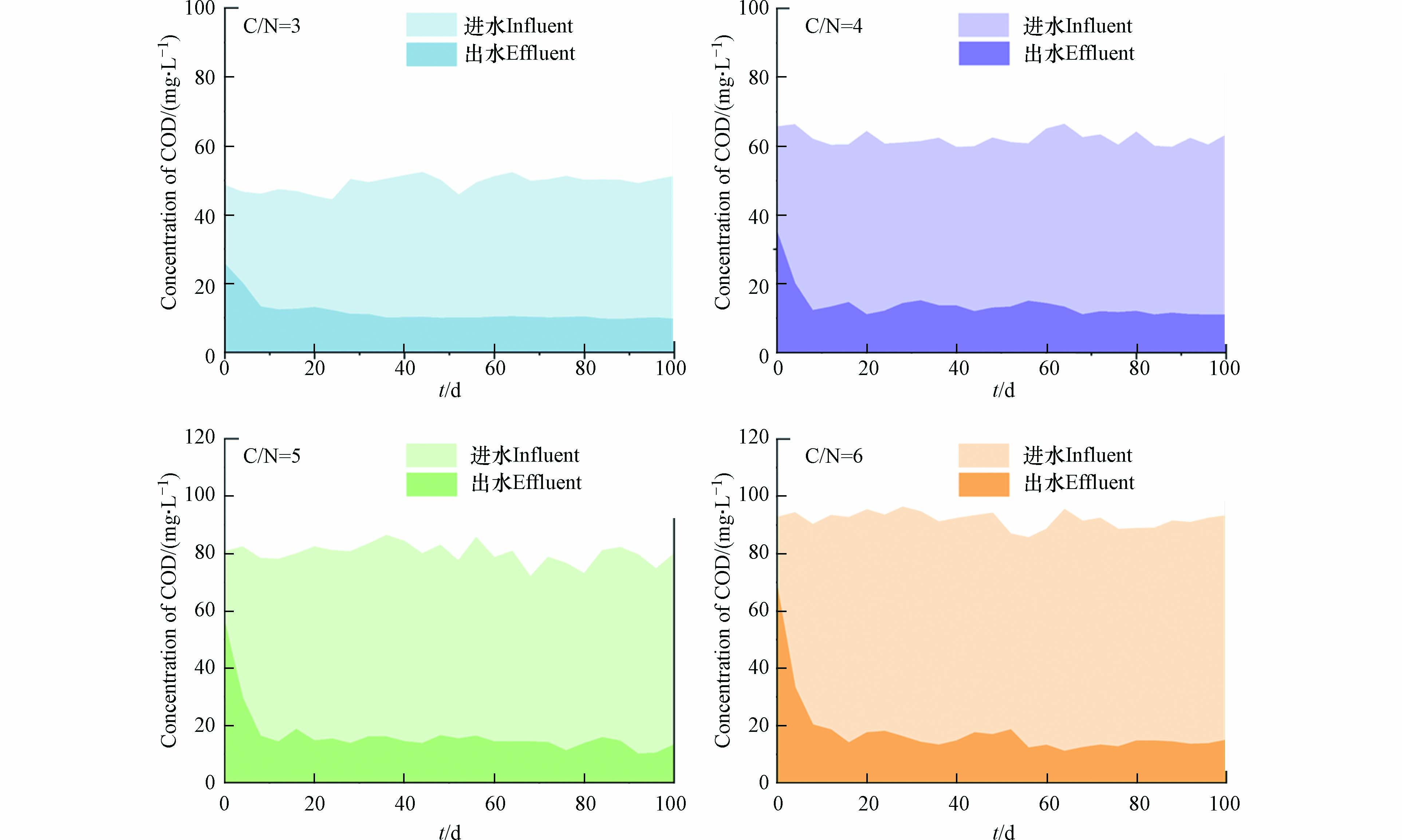
 下载:
下载:
